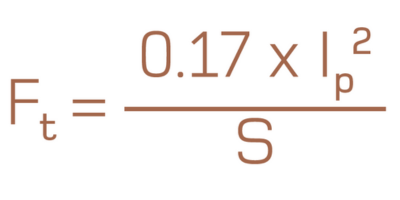
During the design of an electrical installation, cable size will be specified and the maximum anticipated short circuit load will be calculated. Using this data, the force between the conductors in the event of a short circuit can be calculated and the correct cleats at the appropriate spacing can be determined.
Each range of cleats has different features and benefits and mechanical strength varies from product to product. Once the forces between the conductors in the event of a short circuit have been calculated and a cleat has been selected, the spacing is calculated for that specific cleat. If the cleat type is changed, the spacing must be recalculated for the new cleat’s mechanical strength.
The only way to be able to guarantee the performance of a particular type of cleat is by subjecting it to a short circuit test. We know from experience that a cleat may withstand a certain mechanical load when subjected to a simple tensile test but it may fail when subjected to the same load in a short circuit because of the dynamic forces involved.
IEC 61914 provides a method for cable cleats to be short circuit tested so that results for different types of cleats can be compared.
It is up to the cable cleat manufacturer to determine the fault level at which they wish to test their cleat. However, the cable must be unarmoured single core 600V/1000V stranded copper conductor cable and the testing assembly must be in accordance with the requirements of the standard.
For a range of cleats to be classified under the Standard at a particular fault level, it must undergo one or two short circuit tests depending on classification and afterwards:
There shall be no failure that will affect the intended function of holding the cable in place.
The cable cleats and intermediate restraints, if used, shall be intact with no missing parts (minor deformation is acceptable).
There shall be no cuts or damage visible to the outer sheath of the cable caused by the cleats or intermediate restraints.
There shall be no failure that will affect the intended function of holding the cable in place.
The cable cleats and intermediate restraints, if used, shall be intact with no missing parts (minor deformation is acceptable).
There shall be no cuts or damage visible to the outer sheath of the cable caused by the cleats or intermediate restraints.
IEC 61914 also provides formulae to enable the theoretical forces between conductors in the event of a short circuit to be calculated.
For a three-phase short circuit with the cables in a trefoil configuration, the maximum force on the conductor is:

Where:
Ft is the maximum force on the cable conductor (N/m)
Ip is the peak short circuit current (kA)
S is the centre to centre distance between the conductors, which equals the cable diameter in trefoil cable configurations (m)
When comparing short circuit test results for trefoil cleats, the fault level, cleat spacing and cable diameter must be known. It can only be said that a given cleat has specific short circuit withstand at a given cleat spacing for a specific cable diameter.
Ellis Patents Ltd has carried out over five hundred short circuit tests at independent test laboratories across the world, including in the UK, Holland, Germany, Russia and the USA. Test certificates are available for all Ellis fault rated products. Technical advice regarding recommended cleat type and spacing for specific electrical installations is available on request.


Ellis Patents Ltd.
High Street,
Rillington, Malton,
North Yorkshire YO17 8LA
United Kingdom
Company registration number: 10293983
Registered in England and Wales
VAT number: GB125424145
© Ellis Patents 2025 | Terms and Conditions | Cookie Policy | Sitemap
Website by Askew/Brook